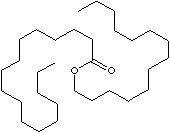| CAS
NO. |
540-10-3 |

|
| EINECS
NO. |
208-736-6 |
| FORMULA |
C32H64O2 |
| MOL
WT. |
480.86 |
|
H.S.
CODE
|
|
|
TOXICITY
|
|
| SYNONYMS |
Hexadecanoic Acid, Hexadecyl Ester; Palmityl palmitate;
|
| n-Hexadecyl
Hexadecanoate; Hexadecyl Palmitate; Palmitic Acid, n-hexadecyl Ester;
Cetyl Palmitate;
|
|
SMILES |
|
|
CLASSIFICATION
|
|
|
GENERAL DESCRIPTION OF FATTY ACID |
|
Fatty Acids are
aliphatic carboxylic acid with varying hydrocarbon lengths at one end of the
chain joined to terminal carboxyl (-COOH) group at the other end. The general
formula is R-(CH2)n-COOH. Fatty acids are
predominantly unbranched and those with even numbers of carbon atoms between 12
and 22 carbons long react with glycerol to form lipids (fat-soluble components
of living cells) in plants, animals, and microorganisms. Fatty acids all have
common names respectively lilk lauric (C12), MyrIstic (C14), palmitic (C16),
stearic (C18), oleic (C18, unsaturated), and linoleic (C18, polyunsaturated)
acids. The saturated fatty acids have no solid bonds, while oleic acid is an
unsaturated fatty acid has one solid bond (also described as olefinic) and
polyunsaturated fatty acids like linolenic acid contain two or more solid
bonds. Lauric acid (also called Dodecanoic acid) is the main acid in coconut oil
(45 - 50 percent) and palm kernel oil (45 - 55 percent). Nutmeg butter is rich
in myristic acid (also called Tetradecanoic acid ) which constitutes 60-75
percent of the fatty-acid content. Palmitic acid(also called Hexadecylic acid )
constitutes between 20 and 30 percent of most animal fats and is also an
important constituent of most vegetable fats (35 - 45 percent of palm oil).
Stearic acid ( also called Octadecanoic Acid) is nature's most common
long-chain fatty acids, derived from animal and vegetable fats. It is widely
used as a lubricant and as an additive in industrial preparations. It is used in
the manufacture of metallic stearates, pharmaceuticals, soaps, cosmetics, and
food packaging. It is also used as a softener, accelerator activator and
dispersing agent in rubbers. Oleic acid (systematic chemical name is
cis-octadec-9-enoic acid) is the most abundant of the unsaturated fatty acids in
nature. |
|
PHYSICAL
AND CHEMICAL PROPERTIES
|
| PHYSICAL
STATE |
white
to off-white waxy solid |
|
MELTING
POINT
|
43
- 53 C |
| BOLING
POINT |
360
C
|
| SPECIFIC
GRAVITY |
|
|
SOLUBILITY
IN WATER
|
Insoluble |
| pH |
|
| VAPOR
DENSITY |
|
| AUTOIGNITION |
|
|
REFRACTIVE
INDEX
|
|
| NFPA
RATINGS |
Health:
1; Flammability: 0; Reactivity: 0 |
| FLASH
POINT |
|
| STABILITY |
Stable
under ordinary conditions |
|
APPLICATIONS
|
| Fatty Acid Esters are used as raw material of emulsifiers or oiling agents for
foods, spin finishes and textiles; lubricants for plastics; Paint and ink
additives; surfactants and base materials for perfumery. They are used as
solvents or co-solvents, oil carrier in agricultural industry. Cetyl palmitate
has similar property to whale wax.
|
| SALES
SPECIFICATION |
|
APPEARANCE
|
white
to off-white waxy solid |
|
SAP
VALUE
|
108
- 120 mg KOH/gm
|
|
MELTING
POINT
|
43 - 53 C |
|
HYDROXYL
VALUE
|
20.0
max mg KOH/gm
|
|
IODINE
VALUE
|
1
max mg KOH/gm
|
| TRANSPORTATION |
| PACKING |
25kgs
in bag |
| HAZARD
CLASS |
not
regulated |
| UN
NO. |
|
| OTHER
INFORMATION |
| Hazard Symbols: n/a, Risk Phrases: n/a, Safety Phrases: 24/25-28A-37-45 |
